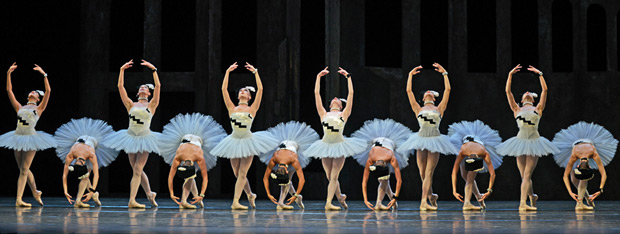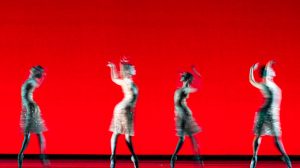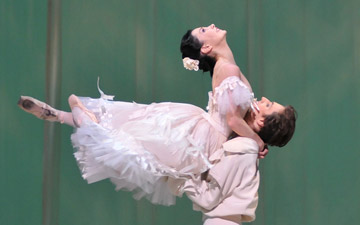
© Dave Morgan, courtesy the Royal Opera House. (Click image for larger version)
Royal Ballet
Ashton mixed bill: Scènes de ballet, Five Brahms Waltzes in the Manner of Isadora Duncan, Symphonic Variations, A Month in the Country
London, Royal Opera House
18 October 2014
Gallery of pictures by Dave Morgan
www.roh.org.uk
Ashton, who wrote that a pure dance piece ‘can leave an audience suspended in a trance-like response that a story ballet can never achieve’, would have been gratified by the hushed reaction to Symphonic Variations on Saturday night. Every now and again a cast is chosen for his 19-minute ballet that succeeds in entrancing spectators before they erupt into joyous applause. On the opening night of this season’s run we were blessed with Vadim Muntagirov making his debut in the leading man’s role. He partnered Marianela Nunez, with Yuhui Choe and Tristan Dyer, Yasmine Naghdi and James Hay, as the side couples.

© Dave Morgan, courtesy the Royal Opera House. (Click image for larger version)
Muntagirov has learnt the art of stillness, calmly proclaiming his presence as the central cog of the ballet. He doesn’t impose his personality: he serves Ashton’s choreography simply and proudly as a danseur noble. When he soars into double tours en l’air or springs into multiple entrechats, his elevation seems to come without effort; his landings are soundless, his fifth positions immaculate. He took charge of Nunez, reassuring her after a slightly rushed start. She eased up, secure in his arms and in her own reliable technique. By the last time they stood still together, breathing before the final burst of dancing, they looked radiantly confident.
The ballet requires great reserves of stamina, for the six dancers never leave the stage. The two secondary women darted tirelessly through their rapid flurries of steps, matching the piano’s cascades of notes in César Franck’s Variations symphoniques, elegantly played by Paul Stobart. The men never flagged, though Hay opted not to risk flinging his head back in pirouettes. When the cast link hands and run in an ecstatic circle, it seems Ashton’s assurance that all will be well, forever and ever.

© Dave Morgan, courtesy the Royal Opera House. (Click image for larger version)
Scènes de ballet, created two years later in 1948, attains a different kind of euphoria in its finale, to Stravinsky’s peals of rejoicing (in 1944) that the Second World War was about to be over. Ashton chose to use a principal couple and a corps of 12 women in serried ranks, with just four male soloists to partner them in the closing section. All their geometric formations, like their timing, have to be precise – which they weren’t on Saturday’s opening night. Arriving a few minutes late for the 7pm start, I watched the performance on the monitor, recorded from high up. Wobbly lines and mistimings were obvious, as were skewed landings by the leading man, Steven McRae, on a rare off-night.
Subtleties of interpretation were largely lost on the monitor, so I cannot comment on the finer points of McRae’s or Sarah Lamb’s performances. Scènes de ballet always takes a while to bed into the repertoire, as dancers and audiences come to terms with its hallucinatory set and quirky procedures. I love the way three women peek through the arches of the mad viaduct at the back and then discreetly vanish once the ballerina establishes herself as the centre of attention.

© Dave Morgan, courtesy the Royal Opera House. (Click image for larger version)
André Beaurepaire’s set vanished in a trice, thanks to modern machinery, leaving the stage bare for Ashton’s evocation of Isadora Duncan in Five Brahms Waltzes. Helen Crawford danced the role created on Lynne Seymour, whose name was not listed in the staging credits. Though the choreography is set, unlike Duncan’s, it should look impulsive in response to the piano music, played on stage (by Kate Shipway, insouciant of wrong notes). Crawford was brave in her commitment to abandoned runs, skips and spins, but she was ahead of the music, knowing what came next. A billowing silken scarf in the fourth waltz gave her the chance to appear more spontaneous, brandishing it like a sail behind her. But as a contribution to the Ashton evening, the dances had little to add.
The concluding narrative ballet, A Month in the Country, needs a special dancer in the role of the mistress of the house, Natalia Petrovna, if all the elements are to fall into place. Zenaida Yanowsky’s Natalia is writ large as a temperamental charmer who has to be placated by everyone around her. Her complaisant husband (Christopher Saunders) appears relieved that her admirer, Rakitin (Gary Avis) can distract her with compliments. Avis and Yanowsky make their relationship realistically intimate, as if you could overhear her manipulating him, rejecting then apologising for hurting him because he understands her feelings.

© Dave Morgan, courtesy the Royal Opera House. (Click image for larger version)
She has the maturity to be good with her young ward, Vera (Emma Maguire) – maternal, jealous, ashamed of her lack of control. Natalia’s choreography is off-balance, a whirlwind of emotions and chattering feet, while Vera’s is dainty, upright, until she throws a tantrum. Rupert Pennefather as the tutor Beliaev, the cause of all the turmoil, is handsome, mild and obliging. Though his infatuation with Natalia overwhelms him, he’ll recover. Vera’s first love is more acutely painful, as is Natalia’s regret at losing her last chance of an adoring affair.

© Dave Morgan, courtesy the Royal Opera House. (Click image for larger version)
Yanowsky captures the poignancy of Natalia’s renunciation without turning it into a tragedy. Ashton’s compact version of Turgenev’s play depicts a summer storm in a samovar, not a Romeo and Juliet disaster. His choreography is astonishing in the way it conveys characters and conflicting emotions, poured out to Chopin’s eminently danceable music. (Far too many wrong notes from pianist Kate Shipway, again.) Audiences fall under his spell, responding with their own feelings, instead of being rapt in a pure-dance trance.

















You must be logged in to post a comment.